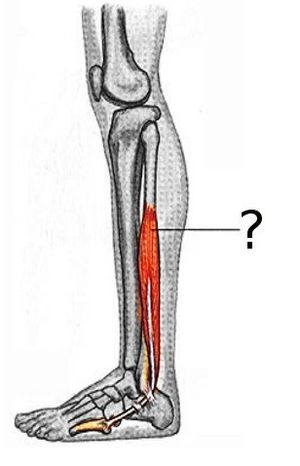Peroneus Brevis: Difference between revisions
No edit summary |
No edit summary |
||
| Line 11: | Line 11: | ||
== Description == | == Description == | ||
[[File:Peroneus brevis.jpg|thumb|The Peroneus brevis muscle origin and insertion. ]] | [[File:Peroneus brevis.jpg|thumb|The Peroneus brevis muscle origin and insertion. ]] | ||
The Peroneus Brevis (also known as Fibularis Brevis) is a short muscle that lies at the lateral part of the lower leg deep to the [[Peroneus (Fibularis) Longus Muscle|Peroneus Longus]].<ref name=":0">Eovaldi BJ, Siccardi MA. [https://www.ncbi.nlm.nih.gov/books/NBK535427/ Anatomy, Bony Pelvis and Lower Limb, Foot Peroneus Brevis Muscle. | The Peroneus Brevis (also known as Fibularis Brevis) is a short muscle that lies at the lateral part of the lower leg deep to the [[Peroneus (Fibularis) Longus Muscle|Peroneus Longus]].<ref name=":0">Basit H, Eovaldi BJ, Siccardi MA. [https://www.ncbi.nlm.nih.gov/books/NBK535427/ Anatomy, Bony Pelvis and Lower Limb, Foot Peroneus Brevis Muscle]. InStatPearls [Internet] 2019 May 19. StatPearls Publishing.</ref> It is one of the three peroneus muscles (Pernoeus Longus, Peroneus Brevis and [[Peroneus Tertius]]).<ref name=":1">Lippert, Lynn S. Clinical Kinesiology and Anatomy. 5th ed. Philadelphia: F A Davis Company; 2016. | ||
</ref> | </ref> The Peroneus Brevis along with the Peroneus Longus are commonly injured during a lateral ankle sprain and the tendon of the Peroneus Brevis muscle is the most commonly dislocated tendon.<ref name=":0" /> | ||
=== Origin === | === Origin === | ||
The Peroneus Brevis originates from the distal two-thirds of lateral fibula.<ref name=":0" /> It's tendon passes downwards and loops posterior to the lateral malleolus.<ref name=":1" /> | |||
=== Insertion === | === Insertion === | ||
The Peroneus Brevis inserts on the styloid process at the proximal end of the fifth metatarsal.<ref name=":0" /><ref name=":1" /> | |||
=== Nerve === | === Nerve === | ||
Superficial | The Peroneus Brevis is innervated by the Superficial Peroneal nerve.<ref name=":0" /> | ||
=== Artery === | === Artery === | ||
The Peroneus Brevis receives its arterial supply from the muscular branches of the peroneal artery.<ref name=":0" /> | |||
== Function == | == Function == | ||
The Peroneus Brevis is responsible for 63% of the power needed to evert the foot as well as assists in plantar flexion along with the Peroneus Longus.<ref name=":1" /><ref name=":2">Davda K, Malhotra K, O’Donnell P, Singh D, Cullen N. [https://www.ncbi.nlm.nih.gov/pmc/articles/PMC5508858/ Peroneal tendon disorders]. EFORT open reviews. 2017 Jun;2(6):281-92.</ref> The peroneii muscle work together to provide dynamic lateral ankle stability during sudden ankle inversion stress.<ref name=":2" /> | |||
== Clinical relevance == | == Clinical relevance == | ||
Revision as of 21:55, 11 November 2020
Original Editor -
Top Contributors - Lilian Ashraf, Beverly Klinger, Kim Jackson, Oyemi Sillo and Abbey Wright
Description[edit | edit source]
The Peroneus Brevis (also known as Fibularis Brevis) is a short muscle that lies at the lateral part of the lower leg deep to the Peroneus Longus.[1] It is one of the three peroneus muscles (Pernoeus Longus, Peroneus Brevis and Peroneus Tertius).[2] The Peroneus Brevis along with the Peroneus Longus are commonly injured during a lateral ankle sprain and the tendon of the Peroneus Brevis muscle is the most commonly dislocated tendon.[1]
Origin[edit | edit source]
The Peroneus Brevis originates from the distal two-thirds of lateral fibula.[1] It's tendon passes downwards and loops posterior to the lateral malleolus.[2]
Insertion[edit | edit source]
The Peroneus Brevis inserts on the styloid process at the proximal end of the fifth metatarsal.[1][2]
Nerve[edit | edit source]
The Peroneus Brevis is innervated by the Superficial Peroneal nerve.[1]
Artery[edit | edit source]
The Peroneus Brevis receives its arterial supply from the muscular branches of the peroneal artery.[1]
Function[edit | edit source]
The Peroneus Brevis is responsible for 63% of the power needed to evert the foot as well as assists in plantar flexion along with the Peroneus Longus.[2][3] The peroneii muscle work together to provide dynamic lateral ankle stability during sudden ankle inversion stress.[3]
Clinical relevance[edit | edit source]
Avulsion fracture of the ankle
Assessment[edit | edit source]
Peroneus longus and brevis tests
Treatment[edit | edit source]
References[edit | edit source]
- ↑ 1.0 1.1 1.2 1.3 1.4 1.5 Basit H, Eovaldi BJ, Siccardi MA. Anatomy, Bony Pelvis and Lower Limb, Foot Peroneus Brevis Muscle. InStatPearls [Internet] 2019 May 19. StatPearls Publishing.
- ↑ 2.0 2.1 2.2 2.3 Lippert, Lynn S. Clinical Kinesiology and Anatomy. 5th ed. Philadelphia: F A Davis Company; 2016.
- ↑ 3.0 3.1 Davda K, Malhotra K, O’Donnell P, Singh D, Cullen N. Peroneal tendon disorders. EFORT open reviews. 2017 Jun;2(6):281-92.
- ↑ Endurance Physio. Ankle Eversion (fibularis longus/brevis) Exercise. Available from:https://www.youtube.com/watch?v=JHyEHEwgc6A&feature=youtu.be [last accessed 13/02/2020]







